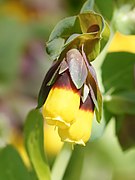Cerinthe major
Appearance
| Cerinthe major | |
|---|---|

| |
| In bloom | |

| |
| A particularly dark cultivar of Cerinthe major subsp. purpurascens | |
| Scientific classification | |
| Kingdom: | Plantae |
| Clade: | Tracheophytes |
| Clade: | Angiosperms |
| Clade: | Eudicots |
| Clade: | Asterids |
| Order: | Boraginales |
| Family: | Boraginaceae |
| Genus: | Cerinthe |
| Species: | C. major
|
| Binomial name | |
| Cerinthe major | |
| Synonyms[2] | |
|
List
| |
Cerinthe major, called honeywort along with other members of its genus, is a species of flowering plant in the genus Cerinthe, native to the Mediterranean region, and introduced to New Zealand.[2] Gardeners have a choice along a spectrum of cultivars ranging from the plain Cerinthe major, with sea-green bracts and yellow flowers, to Cerinthe major subsp. purpurascens with blue bracts and purple flowers.[3]
Subspecies
The following subspecies are currently accepted:[2]
- Cerinthe major subsp. major
- Cerinthe major subsp. oranensis (Batt.) Selvi & L.Cecchi
- Cerinthe major subsp. purpurascens (Boiss.) Selvi & L.Cecchi
References
- ^ Sp. Pl.: 136 (1753)
- ^ a b c "Cerinthe major L." Plants of the World Online. Board of Trustees of the Royal Botanic Gardens, Kew. 2017. Retrieved 13 December 2020.
- ^ Land, Leslie (January 2003). New York Times One Thousand Gardening Questions and Answers. p. 33. ISBN 9780761128861.




